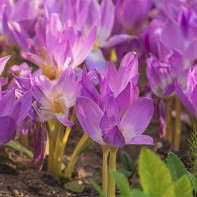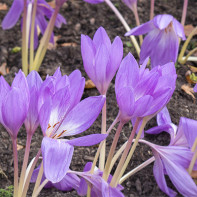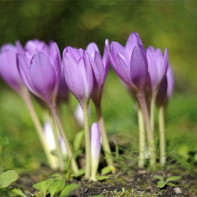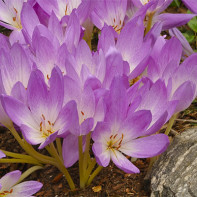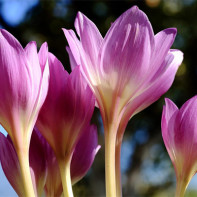Colchicum: medicinal properties and contraindications
The colchicum has got its beautiful name with a touch of romance among the people precisely because its flowers appear in a time unusual for flowering - in simple terms, without time. It blooms in late autumn, when all nature begins to freeze, so its second national name is the autumn tree. Botanists most often call this perennial plant Colchicum - from the word Colchis. It is believed that this historic region on the eastern coast of the Black Sea was home to colchicum.
- Chemical composition
- How it looks and where it grows
- Views
- Collection and storage
- The healing properties of colchicum autumn
- Colchicum in folk medicine
- Tincture of rheumatism and gout
- Infusion for arthritis and gout
- Vinegar tincture for radiculitis
- Seed tincture for joints
- Fresh onion tincture for cystitis
- Ointment for rheumatism
- Infusion for constipation
- Tincture for cancer
- Types of healing compounds
- Infusion
- Tincture
- Ointment
- Contraindications
- First aid for colchic poisoning
Chemical composition
Composition of colchicum has been studied by scientists quite deeply; they found more than 20 alkaloids in the plant. Among them are colchicine and colchamine, which are close in composition and have a similar effect, as well as colchicerin and specosin, which are also relatives and, when processed, are split into colchamine. Colchicine and colchamine are inherently poisons that can inhibit cell division and delay cell reproduction. The whole plant is poisonous, especially a lot of alkaloids in the leaves and seeds, because of their appearance among other herbs it becomes impossible to use pastures. So, a lethal dose of alkaloids is contained in only 6 grams of colchicum seeds. But it is thanks to the alkaloids that it is used in pharmacy.
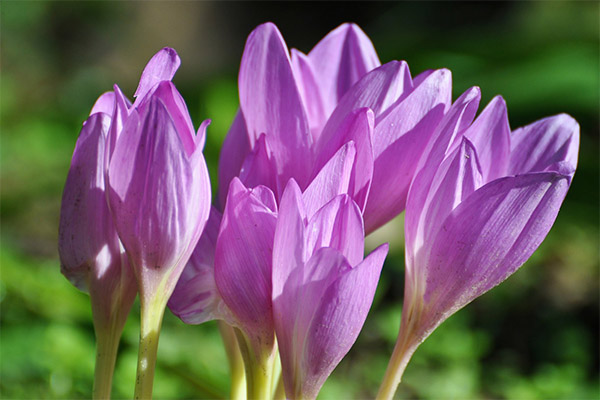
In addition to the alkaloid group of substances, the plant contains phytosterols that can reduce cholesterol and prevent cancer, as well as flavon apigenin, which has anti-inflammatory, antioxidant and antitumor effects. Seeds are rich in lipids, replenishing the energy costs of the body and playing the role of a natural barrier that protects cells. Plant components such as resins help to remove inflammatory processes, heal wounds, reduce pain, and increase the body's immune forces. And the tannins available in colchicum free the body from toxins and toxins up to eliminating the effects of radiation exposure, stop the blood, protect against infection.
In addition, the plant contains a wide range of macro- and microelements in high concentrations: potassium, iron, calcium, zinc, copper, magnesium and selenium.
How it looks and where it grows
Colchicum is a perennial bulbous herbaceous plant. Depending on the type and place of growth, it can be 20 cm high or stretch above half a meter - up to 60 cm. It has a rather large bulb, oval in shape, usually reaches 5-6 cm in length, and smaller in diameter - from 3 to 4 cm Bulb weighs about 40 g, individual outstanding specimens can reach 70–80 g.
Outside, the bulb is covered with dense leathery membranous membranes of dark brown color, which, like a bell, continue to the very stem of the plant and hug its lower part.
Colchicum leaves usually have four to six leaves. They are quite wide, oval-oblong, with a neat rounded top. In length, they reach 18–25 cm, and in this case they have different widths: the upper ones are about 3.5 cm, the lower ones are larger and wider about 7 cm. Each dark green shiny sheet is placed on a long vagina, which can be mistaken for a stem .
Large flowers appear in late autumn, when the trees dropped their leaves long ago, and the colchicum itself no longer has it. There are frequent cases when they grow already from under the first snow.The flower is formed in the place where the topmost leaf grew - right from its sinus. In plants under natural environmental conditions, flowers are pink-purple-violet hue. Colchia grow colchicum with flowers of other colors - including white, yellow, and bluish.
From each bulb, one to four flowers may appear in a shape similar to a bell and a funnel at the same time. The upper edge of the “funnel” is divided into diverging petals, their length is from 5 to 6.5 cm, width is from 1.5 to 2.5 cm. Inside the corolla are six stamens with large anthers, above which a rather thick pistil rises. Despite the fact that the yard is autumn, the plant manages to pollinate. When the colchicum fades, the corolla of the flower with the formed ovaries wilts and winters quietly, covered by a layer of dead leaves and snow. The temperature there is quite comfortable, so that ovaries slowly form and ripen. And in late spring - early summer, round brown seeds with a diameter of 2-3 mm are ready to give life to a new plant.
Colchicum is a photophilous plant of subtropics. It grows in open places, preferring moist, rich soils of meadows and deciduous forests of the southern latitudes of Europe. He is also comfortable in Asia, North Africa, the Mediterranean, as well as in the Caucasus Mountains, in the Krasnodar Territory, in the west of Belarus, Lithuania and Ukraine.
Summer residents and flower growers have learned to grow colchicum in the middle lane, in many regions they grow even without additional shelter for the winter, like tulips.
Views
Colchicum is a large genus of herbaceous plants, which includes almost more than 100 species. Many of them have become favorites of gardeners and florists and, despite the toxicity, they are actively populating flowerbeds of private estates.
In Russia, two species grow in the wild - autumn colchicum and magnificent colchicum. They grow in the Krasnodar Territory, in its southwestern territories, from the foothills of the Caucasus rise along the slopes of the Caucasus Range up to the subalpine zone.
Colchicum autumn
We can say that this is the most common, suitable for all classical descriptions colchicum. Although it is found in Russia, it prefers Europe - its moderately warm moist meadows and glades of chestnut and hornbeam forests. It grows to 40 cm in height.
Colchicum is cheerful
This is the little brother of the fall. It grows in limited areas - only in the lowlands of the Caucasus Mountains and in the lower reaches of the Don and Volga. Local steppes and meadows - this is his favorite place of growth. This plant is slightly smaller than its ancestor, the colchicum of autumn, and accordingly, its bulb will not grow larger than 3 cm. But it is early ripening: it blooms in autumn, like all relatives, in April next year.
Colchicum is magnificent
Also an endemic plant, found in a limited area. His place of residence is the Caucasus Mountains and Transcaucasia. It climbs up the slopes to a height of 3000 m. Since it tolerates partial shade, it grows both in meadows and in beech, hornbeam and chestnut forests.
It is listed in the Red Book of the USSR in 1988, and it is still forbidden to collect it.
Magnificent this look was called for regal beauty. It has long, spectacular leaves of bright green color with a wavy edge. The flowers also amaze even in the bud - they are so beautiful because of their bright pink colors. When revealed, they show the inside of the cup more pale pink or white.
Colchicum Cilician
It is also found in Russia, but gravitates towards the Mediterranean coast of Turkey. There are its main locations. In height, it can grow up to 60 cm, its bulb is also large - 5 cm in diameter. It produces a huge number of flowers in comparison with other colchicum - up to 25 pieces.
Agrippa Colchicum
Its second name is motley. It went, most likely, due to the color of the flowers. They have bright, pink-purple plants with dark spots, like a chessboard. Stamens are not yellow, like the rest of the plants, but orange. You can admire them only in the countries of Asia Minor.
Colchicum ankara, or three-leafed
Although it is called Ankara, it has nothing to do with Ankara. In Turkey, its thickets are available, but not in the center of the country where the city is, but in the west, along the sea coast. In the European part it grows in the mountains of Moldova, in the steppes in the south-west of Ukraine, it is often found in Greece and Bulgaria, thus encircling the Black and Aegean Seas. It grows on not very comfortable clay soils. Its height is not more than 15 cm.
This colchicum belongs to those species that bloom in spring, and not in autumn. And he has only three leaves, no more, which was reflected in his second name.
Colchicum dark magenta
Small plant - from 10 to 15 cm tall. In September, begins to decorate nature with its flowers. When they have just opened, the color is light purple, and after a couple of days they acquire rich colors and turn into fuchsin red. This plant species is the closest relative of the Ankara colchicum.
Bornmüller Colchicum
It bears the name of the German botanist Joseph Bornmüller, who in the 20-30s of the last century made more than one expedition to the Balkans, Greece and described many plant species, including colchicum.
This species is a resident of Iran and the mountains of Asia Minor. Its leaves reach 30 cm in length, and pink-purple flowers are distinguished by a large white spot inside the calyx.
Colchicum Byzantine
Botanists suspect that this species is the closest relative of the Cilician colchicum, from which it may have appeared. Its flowers are larger than in autumn, and the bulb is perhaps the largest and reaches a diameter of 7 cm. It has an irregular shape, which does not prevent it from forming about 12 flowers per flowering. The leaves of the plant are also special - wide, sometimes reaching 15 cm, and also in a fold.
Colchicum colchicum
This species is distinguished by almost white and snow-white flowers, which are rare in nature. Typically, these are breeders for landscape design. They are collected in whole bundles - over 20 pieces in each, hence the name. Flowering begins unusually - in early spring.
The plant itself is low - from 10 to 20 cm, its leaves develop at the same time with flowers.
Colchicum Fomina
It is found only in Ukraine, in the Odessa region, as an endangered species was listed in the Red Book of the USSR and is still in the Red Book of Ukraine. Apparently a nondescript plant, from 6 to 15 cm in height. Each bulb usually produces one flower; 2 or 3 are considered rare. It differs from other autumn colchicum in that it blooms even in dry weather.
Colchicum water-loving
Another Mediterranean Turkish resident. A low plant - up to 20 cm. It differs in a small round bulb - about 2.5 cm. Refers to spring-flowering - flowers are shown as soon as the snow melts. Each bulb forms up to 8 pale pink flowers.
Colchicum yellow
The most mysterious and inaccessible type of plant. It settles very high in the mountains, next to the glaciers, blooms simultaneously with melting snow. And although the plant is low, only 15 cm, and flowers on each of them forms only from 1 to 3, in this wild, almost lifeless place they look stunning. Seeing them is a true gift for climbers climbing the Pamir or Tien Shan, as well as conquering the mountains of India, Afghanistan or Pakistan.
Florists bred many varieties and hybrids based on autumn colchicum. And the main emphasis was on color. Therefore, there are so many now in the gardens of white colchicum, rare in the wild. These are white with a yellow middle, and beautiful double ones, the flowers of which can consist of 50 petals.
Collection and storage
Bulbs of colchicum are first of all suitable for harvesting as medicinal raw materials. They must be carefully dug together with the roots, trying not to cut or scratch, because of the damage they quickly mold and rot. Do not tear off the roots either, they will fall off themselves when they dry.
Gently shake the ground from the dug bulbs, but in no case do not wash - because of the water, the raw material also very quickly binds and deteriorates. Then spread out in the sun with a layer of no more than 8-10 cm to dry well. Then put in a dry and cool, well-ventilated area. Raw materials can be stored for no more than 3 months in glass containers with ground stoppers, since the smell of finished raw materials is not very pleasant, although not sharp.
The best time for harvesting is the time of flowering colchicum, from late August to late October. Work must always be done with gloves and a mask, since all parts of the plant are extremely toxic. Do not take bulbs less than 4 cm in length, they are not very rich in useful substances. It must be remembered that many species of colchicum are classified as rare and endangered plants and therefore are listed in the Red Book. So it is better to harvest raw materials in private courtyards.
And to collect seeds is quite real: after all, the plant itself remains safely growing and delighting others. The most suitable seeds are already formed, matured, having a brown color. By the beginning of summer, when the seed boxes reach the desired condition, they must be cut off and put to dry in the shade, in a well-ventilated place. Then remove the seeds from them, which are stored in paper bags in a dry place.
The healing properties of colchicum autumn
Official medicine uses colchicides in oncology due to its colchamine alkaloid content. It prevents cancer cells from multiplying and stimulates the process of their dissolution. These substances are especially effective in relation to oncological pathologies of the thymus, prostate and pancreas, brain, liver, spleen, adrenal glands.
In addition, colchamine exhibits its anesthetic ability. The alkaloid is slowly excreted from the body, and due to this cumulative effect, its therapeutic effect lasts a long period of time.
Previously, scientific medicine also isolated colchicine for the treatment of cancer pathologies, but nowadays, doctors have refused it, since it is about 7-8 times more toxic than colchamine.
Colchamine in the form of tablets is prescribed, as a rule, in combination with other anticancer drugs, and is also used in the form of ointments for various skin cancers. In addition to the ability to fight cancer cells and anesthetize, it helps lower blood pressure and reduces the treatment time for inflammatory processes. Colchamine pharmaceutical preparations are prescribed for treatment only in a hospital, under round-the-clock supervision of a doctor.
But not only for oncology, pharmacists produce medicines based on colchicum. The healing plant helps to cope with rheumatism, joint diseases, accelerates wound healing, for which it is used by dentists.
Liquid formulations - tinctures and infusions - have a diuretic effect, which is also used by official medicine. In a matter of receptions, such products can remove sand and stones from the kidneys and relieve swelling.
Colchicum in folk medicine
Traditional healers believe that there are so many medicinal qualities in the plant that they should not be neglected, the main thing is to observe the dosage in the most accurate way. The plant is used as a laxative and diuretic, choleretic and diaphoretic, analgesic and emetic.
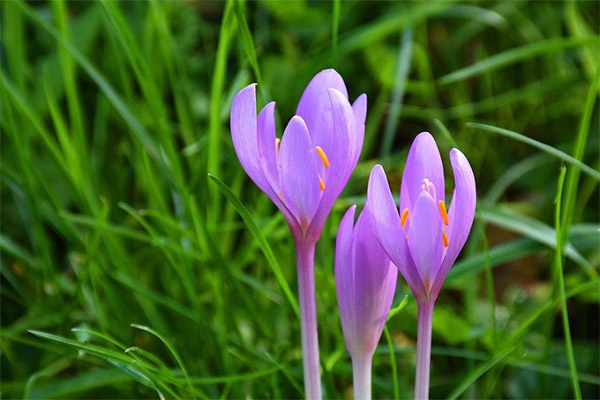
- Since ancient times, doctors have dealt with colchicum with severe bouts of gout, and now traditional medicine continues this practice.
- Highly diluted aqueous infusion in small doses is used to treat pertussis, dropsy, rheumatism, jaundice. It is recommended for getting rid of aches in the bones during a cold, treating heart weakness and neuralgia of a different nature.
- Alcohol tincture, prepared both on the bulbs and on the seeds, is also a good remedy for gout, neuralgia, rheumatism and other joint problems.
Tincture of rheumatism and gout
For rubbing the diseased joints, a tincture of bulbs is prepared. The proportion is as follows: 1 part of the raw material needs 5 parts of 50% alcohol.Grind dry onions, pour them into a glass dish with alcohol, tightly cork and leave in a darkened room for three weeks. Shake the drug periodically, after the specified period, strain. Use for rubbing with gout and rheumatism.
Infusion for arthritis and gout
This product is prepared on water, you need 500 ml of boiling water, which you need to pour half a teaspoon of dried and chopped onion in clay or porcelain dishes. Insist for 2 hours, strain and squeeze the leftovers well. Start taking it drop by drop, gradually increasing the dose, daily intake - 6 times. At most, you can drink 8 ml of water infusion at a time. Wash the product with warm water, be sure to drink at least a glass of liquid. The infusion is recommended for the treatment of gout, arthritis, rheumatism and radiculitis. You can combine internal use with external use as a lotion.
Vinegar tincture for radiculitis
From colchicum can be prepared tincture on vinegar, which can then be successfully used for pain relief for radiculitis and osteochondrosis, rheumatism and arthritis. Take 1 part of vinegar for 1 part of dry chopped bulb of a plant. The medicinal plant is poured into a glass bottle, poured with vinegar, left to infuse for 2 weeks and then filtered. To rub the sore spot is enough a teaspoon of healing composition.
Seed tincture for joints
Tincture on colchicum seeds can be used both as an external remedy and as small doses. The effect will be the same - aching joint and muscle pain will subside. To prepare it, you need to take 10 parts of 70% alcohol for 1 part of the seeds. Mix them in a glass bottle and insist in a dark cupboard for 3 weeks. Shake the bottle from time to time. Strain and drink 15–20 drops three times a day, regardless of the meal. The maximum course of treatment is 2-3 weeks. If it is decided to use the product externally - rub it with a sore spot no more often than 3 times a day.
Fresh onion tincture for cystitis
Those who suffer from cystitis, urolithiasis, edema in the morning, you can recommend tincture from the medicinal plant bulbs. You need to take 2 freshly dug fresh bulbs. Put on gloves and gently rub onions, pour them with good vodka (200 ml). Insist 3 weeks in a dark visit, occasionally shaking. Take 3 times daily, not more than 2 drops per dose, washed down with a glass of warm boiled water. To check how the body will react to colchicum, for the first time it is better to reduce the dose and take only a drop of the drug, after observing at least half a day, there will be signs of poisoning or allergies.
Ointment for rheumatism
For the preparation of ointments, all parts of the plant are suitable. Leaves, bulbs and seeds should be taken in equal volumes. Stir and pour 200 ml of boiled water 3 tablespoons of the mixture of medicinal plants. Boil the resulting infusion in a ladle over low heat until a gray, viscous mass is obtained. Mix the hot mass with vegetable oil in a ratio of 1: 1. As it cools, you can start to apply to lubricate diseased joints before bedtime. For one procedure, a third of a teaspoon of ointment is enough. Do not increase the dose. The tool soothes joint pain with rheumatism, arthrosis, osteochondrosis.
Infusion for constipation
Crush colchicum seeds, take half a teaspoon of raw materials and pour half a liter of boiling water. Wrap well and leave for 3 hours to insist. Take after filtering, serving - half a teaspoon, washed down with a glass of boiled water. The daily norm is 4 doses. The tool improves the activity of the intestine with constipation. Use in rare cases, make the composition a means of daily use is impossible.
Tincture for cancer
To relieve pain in cancer, take 10 g of the seeds of a medicinal plant and pour them with 120 ml of medical alcohol. Insist 3 weeks. After straining, take drop by drop in the morning, at lunch and in the evening. If the pain is unbearable, you can take 2 drops. Wash down the tincture with warm water.
Types of healing compounds
Traditional medicine uses colchicides as diuretics, laxatives, painkillers and vomit. The plant is highly toxic, therefore, it is possible to engage in the preparation of medicinal solutions at home only with gloves, using precautionary measures. Children at this time are better to take for a walk, so that they do not inadvertently grab the sawn-off shotguns or a fragment of a plant.
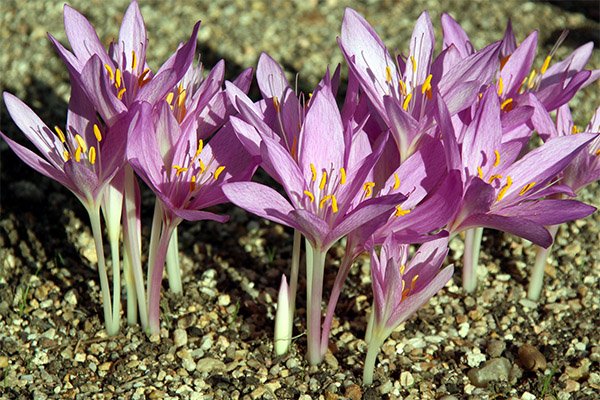
Infusion
Colchicum infusion is prepared in plain water, and then used to reduce edema with dropsy, treat pertussis and jaundice, and also use its painkillers when it breaks bones with colds and flu, arthritis and rheumatism. The tool improves the patient's condition with pain of a neuralgic nature, radiculitis, as well as with heart weakness.
To prepare an infusion of a healing plant, you need to take half a teaspoon of chopped dry onion and, pouring it 500 ml of boiling water, insist for 2 hours. After straining, use the composition for oral administration.
Tincture
If alcohol or vodka is taken for the manufacture of tinctures, the rules for infusion are the same for different medicinal purposes: pour the medicinal raw materials with liquid in a glass or porcelain dish. It is more convenient, of course, in a bottle of dark glass, because during the infusion, the composition must be shaken daily. The infusion process should take place at room temperature in a room where the rays of light cannot reach the drug, you can simply put it in a dark cabinet. Store the finished liquid in the refrigerator. It is important not to forget when applying inside to drink the tincture with a glass of warm boiled water.
For internal use from fresh onions
It is not necessary to wait for the autumn to prepare the bulbs and make medicinal products from them, in case of acute need you can dig up in the summer. Grate a fresh onion or chop it very finely, pour 100 ml of high-quality vodka and insist 3 weeks in a glass container in a dark room, shaking regularly. Filter and take with gout, neuralgia, joint pain, drop by drop per day. For longer than 2 weeks, without medical supervision, the drug can not be used.
For pain relief
Pour dried and chopped colchicum onion with medical alcohol. Liquids in volume take 5 times more than medicinal raw materials. Insist 15 days and apply in two ways to alleviate suffering with rheumatic pains. You can take 1-2 drops by mouth before bedtime or rub sore spots.
Diuretic
Dry onions can not be crushed, but just crush and pour them with 200 ml of high-quality vodka. Insist 2 weeks, strain and drink in the morning at lunch and in the evening, 2 drops for swelling, cystitis, stones or sand in the kidneys.
Anemia seed tincture
This tincture is effective both when taken orally and for external use. To prepare it, you need to take 100 g of seeds and half a glass of medical alcohol. Squeeze the seeds a little, pour into a container with alcohol and shake to mix better. Insist for 3 weeks, strain and take dropwise daily. You can rub the healing elbows, sore elbows, knees, lower back, if the joints ache. It is important not to exceed the dose, half a tablespoon per rubbing is enough.
Ointment
To make the ointment at home, you need to chop 3 colchicum bulbs (300 g), part can be replaced with finely chopped leaves.Pour medicinal raw materials with water (2 cups) and send to a water bath. Evaporate the composition for at least 30 minutes, remove, after cooling, strain and mix with petroleum jelly.
If there is no petroleum jelly, butter to a creamy consistency is also suitable. You need to store homemade ointment in the refrigerator, closing it with a reliable tight lid. A composition is used to relieve pain with exacerbations of arthritis, rheumatism, radiculitis or gout. You need to ointment a sore spot once a day, it is recommended to take no more than a third of a teaspoon of a medicinal product for the procedure.
Contraindications
Considering that colchicum is poisonous, everyone should be serious about taking it, and before using formulations based on a medicinal plant, be sure to consult your doctor and strictly follow all his recommendations. If, in connection with the decision to be treated as colchicum, additional examinations will be necessary before or during the course of admission, it is imperative to pass all of them and take the necessary tests. The fact is that the active substance colchamine in excessive doses can provoke leukopenia - that is, a violation of the hematopoiesis mechanism, and also cause a number of side effects. Therefore, funds from colchicum are strictly contraindicated for pregnant women, people suffering from renal or hepatic insufficiency, problems with bone marrow, purulent diseases.
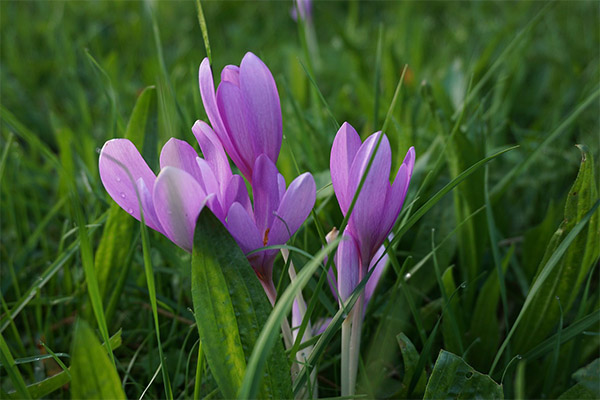
For the same reason, the ointment from this medicinal plant should not be applied close to the organs lined with mucous membranes - eyelids, mouth, and rectum. Mucous membranes absorb colchamine much faster than the skin.
Colchicum with diarrhea is contraindicated, since it itself provokes diarrhea, as well as with a disease such as diabetes, as it is a diuretic.
The compositions from this medicinal plant are not prescribed to patients who have received as a result of a disease such a serious complication as neutropenia, in which the number of neutrophils in the body rapidly plays an important role in the destruction of pathological microorganisms.
If there is the slightest suspicion of internal bleeding - tarry stools or blood in the vomit - colchicum is also prohibited.
First aid for colchic poisoning
In case of overdose and colchic poisoning, first there is a burning sensation in the throat, then nausea and vomiting, moreover, with strong content of bile, stomach mucus and even blood. The stomach and oral cavity are very sore. The chair is very liquefied and becomes an unpleasant, pungent odor. A person is constantly thirsty, his face becomes pale, his lips - blue. Mucus may appear on the skin.
The pulse becomes very uneven - sometimes quickened, then slowed down. Tachycardia, as blood pressure decreases, is replaced by bradycardia. The picture of cardiac abnormalities is accompanied by pain behind the sternum. If urgent measures are not taken, the case may result in convulsions, paralysis and spasm of the respiratory tract.
Such symptoms are characteristic both for poisoning during treatment, if the recommended dose of the drug is exceeded, and if safety rules are not observed when caring for the plant or procuring the medicinal raw material. In the second case, of course, the clinical picture will not be so bright. But the help of a doctor in any case is required immediately. The second – third days from the moment of poisoning are considered the most dangerous. If the patient is left without medical assistance, internal organs may begin to fail.
While the ambulance is traveling, you can take a capsule of the drug sorbex or several tablets of activated carbon (calculation is a tablet per kilogram of the weight of the poisoned person) and then rinse the stomach with a pale pink solution of potassium permanganate. Also, before the doctor arrives, you need to drink plenty of plain boiled water or milk.
The picture of poisoning develops slowly, it is stretched over several days, so it is important not to let the situation go by its own accord.Doctors will take all measures to save and prescribe treatment, will introduce solutions of sodium chloride (saline) and glucose. If breathing problems are observed, oxygen will be prescribed.
But we must remember that the antidote to colchic poison does not exist. Treatment will focus on relieving symptoms of poisoning. Moreover, if the poisoning was severe, the patient was left without medical assistance for a long time, then in the process of recovery, another sign may appear - hair loss.
«Important: all information on the site is provided exclusively in fact-finding purposes. Before applying any recommendations, consult with a profile specialist. Neither the editors nor the authors are liable for any possible harm caused materials. "

